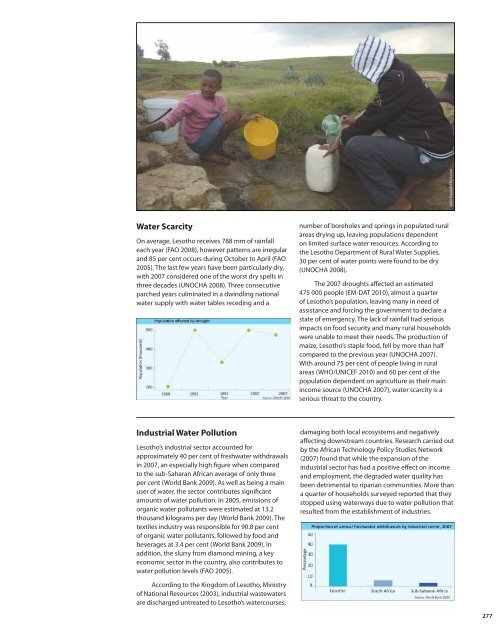Africa Water Atlas - UNEP/GRID-Sioux Falls
Africa Water Atlas - UNEP/GRID-Sioux Falls
Africa Water Atlas - UNEP/GRID-Sioux Falls
You also want an ePaper? Increase the reach of your titles
YUMPU automatically turns print PDFs into web optimized ePapers that Google loves.
John Pannell/Flicrk.com<br />
<strong>Water</strong> Scarcity<br />
On average, Lesotho receives 788 mm of rainfall<br />
each year (FAO 2008), however patterns are irregular<br />
and 85 per cent occurs during October to April (FAO<br />
2005). The last few years have been particularly dry,<br />
with 2007 considered one of the worst dry spells in<br />
three decades (UNOCHA 2008). Three consecutive<br />
parched years culminated in a dwindling national<br />
water supply with water tables receding and a<br />
number of boreholes and springs in populated rural<br />
areas drying up, leaving populations dependent<br />
on limited surface water resources. According to<br />
the Lesotho Department of Rural <strong>Water</strong> Supplies,<br />
30 per cent of water points were found to be dry<br />
(UNOCHA 2008).<br />
The 2007 droughts affected an estimated<br />
475 000 people (EM-DAT 2010), almost a quarter<br />
of Lesotho’s population, leaving many in need of<br />
assistance and forcing the government to declare a<br />
state of emergency. The lack of rainfall had serious<br />
impacts on food security and many rural households<br />
were unable to meet their needs. The production of<br />
maize, Lesotho’s staple food, fell by more than half<br />
compared to the previous year (UNOCHA 2007).<br />
With around 75 per cent of people living in rural<br />
areas (WHO/UNICEF 2010) and 60 per cent of the<br />
population dependent on agriculture as their main<br />
income source (UNOCHA 2007), water scarcity is a<br />
serious threat to the country.<br />
Industrial <strong>Water</strong> Pollution<br />
Lesotho’s industrial sector accounted for<br />
approximately 40 per cent of freshwater withdrawals<br />
in 2007, an especially high figure when compared<br />
to the sub-Saharan <strong>Africa</strong>n average of only three<br />
per cent (World Bank 2009). As well as being a main<br />
user of water, the sector contributes significant<br />
amounts of water pollution. In 2005, emissions of<br />
organic water pollutants were estimated at 13.2<br />
thousand kilograms per day (World Bank 2009). The<br />
textiles industry was responsible for 90.8 per cent<br />
of organic water pollutants, followed by food and<br />
beverages at 3.4 per cent (World Bank 2009). In<br />
addition, the slurry from diamond mining, a key<br />
economic sector in the country, also contributes to<br />
water pollution levels (FAO 2005).<br />
damaging both local ecosystems and negatively<br />
affecting downstream countries. Research carried out<br />
by the <strong>Africa</strong>n Technology Policy Studies Network<br />
(2007) found that while the expansion of the<br />
industrial sector has had a positive effect on income<br />
and employment, the degraded water quality has<br />
been detrimental to riparian communities. More than<br />
a quarter of households surveyed reported that they<br />
stopped using waterways due to water pollution that<br />
resulted from the establishment of industries.<br />
According to the Kingdom of Lesotho, Ministry<br />
of National Resources (2003), industrial wastewaters<br />
are discharged untreated to Lesotho’s watercourses,<br />
277
















